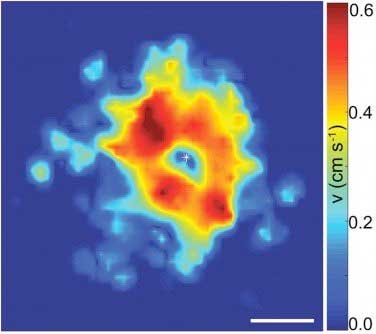| May 24, 2019 | |
Tiny vortices could one day haul microscopic cargo(Nanowerk News) Moving molecules or other small particles across a surface is difficult. Controlling tiny magnetic spheres driven far from equilibrium may open up new ways to move such cargo. In this research, scientists identified how such nickel spheres could form particle-moving vortices. |
|
| The team found that the assembled spheres spontaneously switch the vortex’s sense of rotation, and capture and transport cargo particles. The magnetic liquids have directed transport capabilities not-yet obtainable using current approaches (Nature Communications, "Manipulation of emergent vortices in swarms of magnetic rollers"). | |
 |
|
| Researchers use alternating magnetic fields to drive particles, about the width of a human hair, far from equilibrium so that they roll in a particular direction. At specific field frequencies, free-moving funnel-shaped vortices form from these rollers. Potentially, scientists could direct these vortices to transport and assemble particle-based materials similar to how human cells convey cargo. Color changes in this experimental snapshot track velocities of magnetic rollers comprising an emergent vortex. The fastest particles are located toward the center. Velocity scale is in centimeter/second. Scale bar is 2 µm. (Image: Argonne National Laboratory) | |
| To build micro-robotic devices or other self-assembled transport systems, scientists need to know how to manipulate self-assembled structures such as these vortex-producing spheres. The work offers fundamental insights into how the active vortices interact with passive particles (cargo). The study suggests how scientists might use the interactions to control vortices and transport particles at the microscale to build materials for self-healing or self-assembly. | |
| Dissipative colloidal materials which exist out of equilibrium use energy to generate and maintain structural complexity. The energy injection rate, properties of the environment, and type of activity are important control parameters that influence the outcome of dynamic (active) self-assembly. | |
| Argonne National Laboratory scientists explored out-of-equilibrium active rolling ferromagnetic nickel particles near solid interfaces in water. When exposed to specific alternating magnetic fields, swarms of active rollers that formed from a combination of self-propulsion and particle alignment interactions exhibited complex collective behavior resulting in emergence of self-organized roller vortices. | |
| The mechanism of how the colloids roll is independent of the kind of liquid used and all of the particle interactions could be easily tuned by adjusting the magnetic field. In contrast to what scientists previously believed, these active vortex patterns did not require geometrical confinement for their observation, moving freely across the surface. This unrestrained movement allows the vortex core to travel across the bottom surface of the experimental container. | |
| What happens when the core encounters an inert particle that is not affected by the applied magnetic field depends on the size of that particle. If the particle is large enough, it destroys the vortex state. Smaller particles get vacuumed up and incorporated into the vortex, consuming part of the energy that stabilizes the funnel. In response, the vortex will spontaneously re-assembly itself in a new location. Mobile intermediate-sized particles were captured and transported by the active vortices. | |
| However, when the vortex core encountered an immobile particle, the vortex’s ability to freely move is suppressed, and it gets pinned at that spot. The coupled and rotationally synchronized rollers will adjust their interactions within the vortex assembly to keep the eye of the vortex pinned to the particle and maintain stability of the vortex. | |
| This ability to use defects in the form of various types of inert particles provides a potentially very useful tool to manipulate active roller vortex dynamics and direct transport of cargo in these systems. | |
| Lastly, and quite unexpectedly, the results also demonstrated the self-assembled magnetic spheres have the ability to spontaneously switch the direction of vortex rotation, possibly due to temporary loss and rapid recovery of the over-all synchronization among rollers that form the vortex. |
| Source: U.S. Department of Energy, Office of Science | |
|
Subscribe to a free copy of one of our daily Nanowerk Newsletter Email Digests with a compilation of all of the day's news. |
